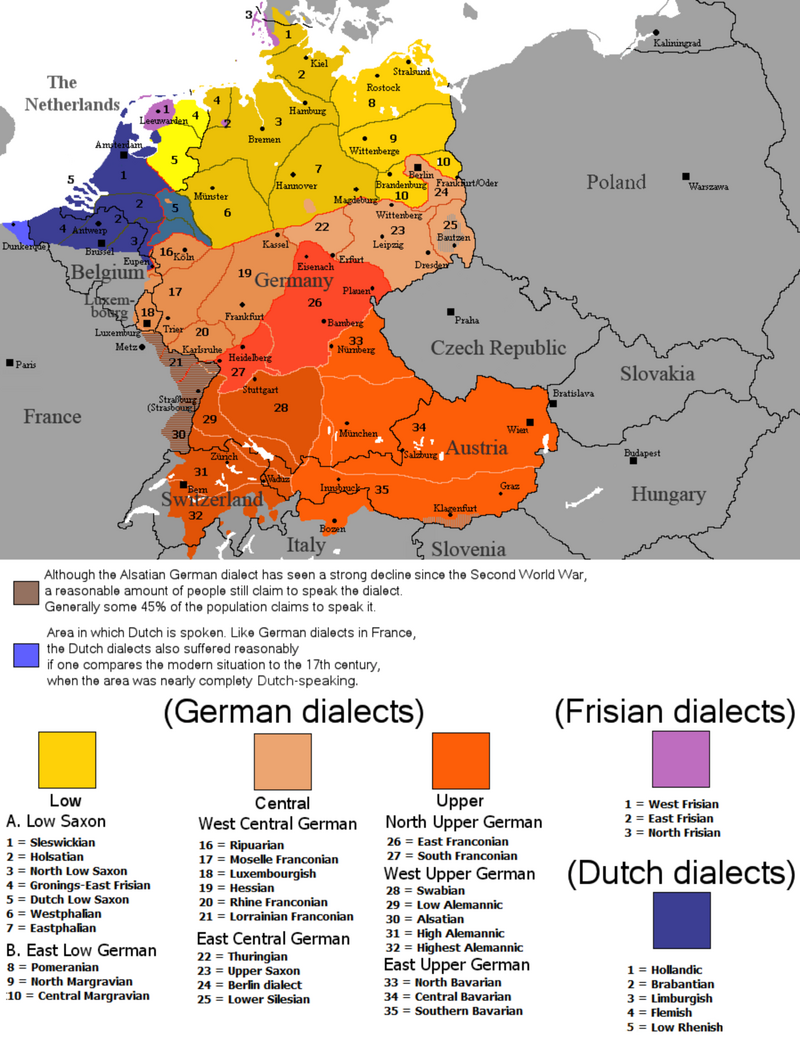https://dmnes.wordpress.com/2015/12/11/nicknames-feminine-diminutive-suffixes-in-medieval-german/
In one of the last posts, the DMNES researchers take a look at an area which has an amazing diversity of diminutive suffixes used in women’s names: medieval Germanic dialects (including Dutch ones from the Low Countries, because of their close kinship with Low German suffixes).
In terms of the vocabulary that they introduced in their previous post, German feminine nicknames were, for the most part, formed by adding such diminutive suffixes, rather than creating a hypocoristic form by truncating it (there are a few exceptions, such as Els, from Elizabeth, and Greta from Margaret.) These diminutive suffixes varied by dialect and by region, making it possible to identify, sometimes with a high level precision, where a name comes from on the basis of the type of suffix that it uses. So let’s start by taking a look at the distribution of the various dialects, and their divisions into Low German, Middle (Central) German, and High (Upper) German:
Starting in the south, High German dialects are typified by diminutives formed from -lin, including variants such as Swiss -li and Bavarian -el or -l. Examples of names formed with this diminutive suffix include Aͤnnlin, Aͤnlin, Aͤndlin, andBridlin, Elsslin, and Bettlin, diminutives of Anne, Brid (Bridget), and Elizabeth(respectively) found in Rottweil, Baden-Württemberg, in 1441. [1] From the same source, we also have Keterlin, Kaͤtherlin, Kaͤterlin, diminutives of Katherine. These particular examples, from Rottweil, are likely examples of -lin added to a hypocoristic of Katherine, but other examples, from further south and east, may involve the Bavarian or Austrian diminutive -erl plus -lin.
-lin and -lyn are typical of Middle High German; it wasn’t until the shift into Early New High German that the spelling -lein starts to appear, such as Marlein (fromMary), Grethlein (from Margaret), Ketherlein (from Katherine), and Elßlein (from Elizabeth), all found in Kulmbach in 1495. [3]
People are often surprised to find nicknames in medieval records, since there can be a misconception that the only things that made it into medieval documents were the formal forms of names. Certainly it is the case that there were probably many more nicknames in use than the documentary evidence displays. The examples we have in written records were almost certainly predated by spoken examples, perhaps by centuries. But nicknames were not wholly excluded from formal documents: If this was the form of the name that the person was known by, this would’ve been the form used to refer to him in a record. As it turns out, the suffix -lin or -lyn are relatively old: German masculine examples can be found in Latinized contexts from the 13th C, including Choncelinus 1280 and Cunzelin1294 (from Conrad), Reinboldelinus 1286 (from Reinbald), and Volfelinus c. 1236 (from Wolf). [2] But we’ll say more about masculine nicknames in another post! Another diminutive suffix whose use can be dated to at least the 13th C is -i, in the feminine names Beli 1267 and Jutzci 1295. [2]
In Low German, -ke(n) and its derivative are typical, found also in the Low Countries, and connected to Slavic -ka. (Diminutives of -ke also stretch further north, being found in Scandinavia.) While we have more examples of this suffix used with men’s names than women’s names, this is primarily an artifact of our data (containing more men’s names than women’s), rather than reflecting anything about the reality of the use of the suffix by women. Examples of this from across the Low German-speaking spectrum include An(n)eke (from Anne), found in Estonia and Latvia, Heilka, a diminutive of some name beginning with Old High German heil, hele ‘whole’ found in the mid 12th C, and Kattryneke, also found in Latvia. In the Low Countries, we can see examples such as Saerken(from Sara), Aelken (from Alice), Neelken (from Cornelia) [4], Claerken (fromClara), Grietken (from Margaret), Mariken (from Mary), Jacomynken (a double diminutive from Jacomine, a variant of Jacoba via the form Jacoma) [5] as well as Tanneken (from Anne), a variant which we just found an example of amongst the Dutch Protestant community in London in the 16th C.
In between these, -chen is characteristic of Middle German dialects, and it is a cousin of another Dutch diminutive, -ge(n). Most of our examples of this, so far, come from the Low Countries, with names like Claertgen (from Clara), Aeltgen(from Alice), Grietgen (from Margaret), Ariaentgen and Adriaentgen (fromAdriana), and Maritgen, Marijtgen, and Marrijtgen from (from Mary) [6].
REFERENCES
[1] Mack, Eugen, Das Rottweiler Steuerbuch von 1441. Königsfestgabe des Rottweiler Geschichts und Altertumsvereins unter der Schirmherrschaft Seiner Majestät König Wilhelms II von Württemberg. (Tübingen, H. Laupp, 1917.), pp. 126-151
[2] Socin, Adolf, Mittelhochdeutsches Namenbuch. Nach oberrheinischen Quellen des 12. und 13. Jahrhunderts (Basel: Helbing & Lichtenhahn, 1903; Hildesheim: Georg Olms Verlagsbuchhandlung, 1966), pp. 10, 31, 48-9, 52-3, 63, 174.
[3] Wilhelm Lederer, Kulmbacher Einwohner 1495, in: Geschichte am ObermainBand 3, Jahresgabe 1965/66, Lichtenfels, S. 71-81.
[4] Daniel van der Meulen, Brieven en Andere Bescheiden Betreffende Daniel Van der Meulen, 1584-1600: Deel 1, Augustus 1584-September 1585, (‘s-Gravenhage : M. Nijhoff, 1986-)
[5] Fonds Plaiser, Antwerpsch Archievenblad.
[6] van de Spiegel, Ronald & Frans van Rooijen, “Kohieren van Het Weekgeld 1573” (http://www.interphrase.nl/frans/FransWeb/Archivalia/WEEKGE.INL.htm)

No comments:
Post a Comment